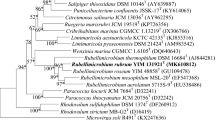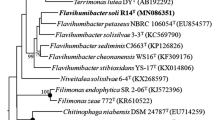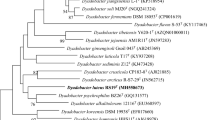Abstract
A novel pink-coloured, non-spore-forming, non-motile, Gram-negative bacterium, designated YIM 48858T, is described by using a polyphasic approach. The strain can grow at pH 6.5–9 (optimum at pH 7) and 25–30°C (optimum at 28°C). NaCl is not required for its growth. Positive for oxidase and catalase. Urease activity, nitrate reduction, starch and Tween 80 tests are negative reaction. 16S rRNA gene sequence similarity studies showed that strain YIM 48858T is a member of the genus Rubellimicrobium, with similarities of 96.3, 95.7 and 95.5% to Rubellimicrobium mesophilum MSL-20T, Rubellimicrobium aerolatum 5715S-9T and Rubellimicrobium thermophilum DSM 16684T, respectively. Q-10 was the predominant respiratory ubiquinone as in the other members of the genus Rubellimicrobium. The major polar lipids were diphosphatidylglycerol, phosphatidylcholine, phosphoglycolipid, glycolipid and the major fatty acids were C18:1 ω7c, C16:0 and C10:0 3-OH, which are very different from the valid published species. The DNA G + C content was 67.7 mol%. Both phylogenetic and chemotaxonomic evidence supports that YIM 48858T is a novel species of the genus Rubellimicrobium, for which the name Rubellimicrobium roseum sp. nov. is proposed. The type strain is YIM 48858T (=CCTCC AA 208029T =KCTC 23202T).
Similar content being viewed by others
Avoid common mistakes on your manuscript.
Introduction
The genus Rubellimicrobium was established by Denner et al. (2006) for a thermophilic bacterium. To this day, the genus comprises three validly published species, Rubellimicrobium thermophilum (Denner et al. 2006), Rubellimicrobium mesophilum (Dastager et al. 2008) and Rubellimicrobium aerolatum (Weon et al. 2009). During our long-term investigations on the microbial diversity of Southwest of China, a new bacterium YIM 48858T was isolated. In the present study, the strain was proposed as a novel species of the genus Rubellimicrobium.
Materials and methods
Isolation and maintenance of organism
Soil samples were collected from tropical rainforest in Xishuangbanna, Yunnan Province, southwest of China. The soil sample was dried at 28°C for 1 week, then pretreated for 1 h at 80°C. Strain YIM 48858T was isolated using plate dilution on Gauze 1 agar (Gauze et al. 1983) with nystatin 100 mg and Nalidixic Acid 25 mg (1 l). The incubation for isolation was performed at 28°C for 10 days. The strain was maintained on Medium YIM 38 (Jiang et al. 2007), at 4°C and a glycerol suspension (20%, v/v) at −80°C. Strain YIM 48858T was deposited in the Collection Center of Typical Cultures, China (CCTCC) with type strain number CCTCC AA 208029T and in the Korean Collection for Type Cultures (KCTC) as strain KCTC 23202T.
Morphological, physiological and biochemical characteristics
Morphological, physiological and biochemical studies were performed with cells grown on YIM 38 at 28°C. Morphological characteristics of the strain were observed by light microscopy (model BH 2; Olympus) and by transmission electron microscopy (model H-800; Hitachi). Gram staining was carried out by using the standard Gram reaction (Doetsch 1981) combined with the KOH lysis test method (Gregersen 1978). Cell motility was confirmed by the presence of turbidity throughout the tube including semisolid medium (Leifson 1960). Growth was tested at 0, 4, 10, 15, 20, 25, 28, 30, 37, 45 and 55°C, and at different pH values (pH 4.0–10.0, in increment of 0.5 pH unit) using the buffer systems 0.1 M citric acid/0.1 M sodium citrate (pH 4.0–5.0), 0.1 M KH2PO4/0.1 M NaOH (pH 6.0–8.0) and 0.1 M NaHCO3/0.1 M Na2CO3 (pH 9.0–10.0). Tolerance against salt were determined at various concentrations of NaCl (0, 1, 3, 5, 7, 10, 15, 20 and 25% w/v). Catalase activity was determined by production of bubbles after the addition of a drop of 3% H2O2. Oxidase activity was observed by oxidation of tetramethyl-p-phenylenediamine. Urease activity, milk coagulation and peptonization, H2S production, nitrate reduction and hydrolysis of cellulose were tested as described by Smibert and Krieg (1994). Hydrolysis of Tweens 20, 40, 60 and 80, gelatin and starch were determined as described by Cowan and Steel (1965). Other enzyme activities were tested by using the API ZYM system (bioMérieux) according to the manu manufacturer’s instructions. Utilization of sole carbon and sole nitrogen sources and energy were performed using the previous methods (Stevenson 1967; Tsukamura 1966). Three type strains were tested in the identical experiment, too.
Chemotaxonomy
Cell mass of strain YIM 48858T for chemical and molecular systematic analyses was harvested after incubation at 28°C for 10 days in shaking-flasks (about 150 r.p.m.) of YIM 38 agar. Polar lipids were extracted, examined by two-dimensional TLC, and identified using the procedures described by Minnikin et al. (1984). The lipoquinone was investigated as described by Komagata and Suzuki (1987), using reversed-phase HPLC. For cellular fatty acid analysis, cell mass was harvested from R2A flasks on a rotary shaker at 150 r.p.m. for 3 days at 28°C. The fatty acids were extracted, methylated and analysed using the standard Microbial Identification System (MIDI) (Sasser 1990; Kämpfer and Kroppenstedt 1996). The fatty acids of the three type strains were examined using the same conditions.
Molecular analysis
Genomic DNA of strain YIM 48858T for the determination of G + C content was extracted as described by Marmur (1961). The G + C content of the DNA was determined by reversed-phase HPLC method (Mesbah et al. 1989).
Extraction of genomic DNA and PCR amplification of the 16S rRNA gene were done as described by Li et al. (2007). The resulting 16S rRNA gene sequence was compared to sequences obtained from the EzTaxon server (http://www.eztaxon.org/) (Chun et al. 2007) to find the most closely related species. Multiple alignment with sequences of the most closely related strains was carried out using CLUSTAL_X (Thompson et al. 1997). Phylogenetic analyses were performed using three tree-making algorithms, the neighbour-joining (Saitou and Nei 1987), maximum-likelihood (Felsenstein 1981) and maximum-parsimony (Fitch 1971) methods. Distances were calculated by Kimura’s two-parameter model (Kimura 1980). A phylogenetic dendrogram was constructed using MEGA version 3.1 (Kumar et al. 2004) with the neighbor-joining method. Bootstrap analysis was used to evaluate the tree topology of the neighbour-joining data by means of 1000 replicates (Felsenstein 1985). Pleomorphomonas oryzae F-7T (AB159680) was used as an outgroup.
Results and discussion
Cells of strain YIM 48858T were irregular rods, approximately 0.8–1 μm wide and 1.8–2.2 μm long after cultivation for 6 days at 28°C on YIM 38 agar. Cells were Gram-negative, non-motile and non-spore-forming, containing poly-β-hydroxybutyrate. Colonies were rose-coloured, circular and clearly protuberant and hard texture after growth on ISP 2 agar for 6 days at 28°C. Strain YIM 48858T grew at 25–30°C and pH 6.5–9, but showed no growth when medium was supplemented with 1% NaCl. Physiological and biochemical characteristics of strain YIM 48858T are given in Table 1 and in the species description.
The diagnostic phospholipids of strain YIM 48858T were diphosphatidylglycerol (DPG), phosphatidylcholine (PC), phosphoglycolipid (PGL) and glycolipid (GL). The predominant respiratory lipoquinone was Q-10, and contained a little Q-9. Major cellular fatty acids were C18:1 ω7c, C16:0 and C10:0 3-OH.
The genomic DNA G + C content of strain YIM 48858T was 67.7 mol%.
An almost-complete 16S rRNA gene sequence (1466 bp) was determined in this study. An association supported by the three tree-making algorithms based on 16S rRNA gene sequence showed that strain YIM 48858T belongs to the genus Rubellimicrobium, and the strain formed a distinct branch in the genus Rubellimicrobium supported by a high bootstrap value 94% in the neighbour-joining and 76% in the maximum-parsimony analysis (Fig. 1). This grouping was also supported by the maximum-likelihood analysis (not shown). 16S rRNA gene sequence similarity studies showed that strain YIM 48858T is a member of the genus Rubellimicrobium, with similarities of 96.3, 95.7 and 95.5% to Rubellimicrobium mesophilum MSL-20T, Rubellimicrobium aerolatum 5715S-9T and Rubellimicrobium thermophilum DSM 16684T, respectively.
Phylogenetic tree showing the phylogenetic position of strain YIM 48858T within the radiation encompassing related genera of the family Rhodobacteraceae. The tree of the 16S rRNA gene sequences generated by the two methods (NJ and MP). Numbers (NJ/MP) on branch nodes are bootstrap percentages (1000 resamplings, only values over 50%/500 are given) for NJ and MP analyses. Bar, 1 substitution per 100 nt
Taxonomic conclusion
The predominant respiratory lipoquinone Q-10 of the strain YIM 48858T and some physiological and biochemical characteristics (in the species description) were consistent with the genus Rubellimicrobium. However, strain YIM 48858T could be differentiated obviously from the three related Rubellimicrobium species by following feature. Growth temperature range of strain YIM 48858T is narrow (25–30°C) and living in soil. Rubellimicrobium aerolatum 5715S-9T is from air. Rubellimicrobium thermophilum DSM 16684T is thermophile. The strain can use citrate as sole carbon source, whereas the three species can not. DNA G + C content (67.7 mol%) of strain YIM 48858T was lower for 1.3–4.7 mol% than other three species. For fatty acid analysis, content of C10:0 3-OH was present in strain YIM 48858T, but absent in the three validly published species. All these results supported the proposal of strain YIM 48858T as representing a novel species of the genus Rubellimicrobium, Rubellimicrobium roseum sp. nov.
Description of Rubellimicrobium roseum sp. nov
Rubellimicrobium roseum (ro’se.um. L. neut. adj. roseum rose-coloured, the colour of colony of the type strain).
Aerobic, non-motile, non-spore-forming, irregular rods (0.8–1 × 1.8–2.2 μm), Gram-negative bacterium contains poly-β-hydroxybutyrate. Colonies are pink-coloured, circular and clearly protuberant after growth on ISP 2 agar for 6 days at 28°C. Growth temperature occurs in very narrow range (25–30, optimally around 28°C) and pH range is 6.5–9 (optimum 7). No growth in the presence of NaCl. Oxidase- and catalase-positive. Degrades Tweens 20, 40 and 60. Urease activity, H2S production, nitrate reduction, milk coagulation and peptonization, hydrolysis of gelatin, cellulose, starch and Tweens 80 tests are negative reaction. Alkaline phosphatase, esterase (C4), esterase lipase (C8), lipase (C14), leucine arylamidase, valine arylamidase, cystine arylamidase, trypsin, naphthol-AS-BI-phosphohydrolase and α-glucosidase are positive. α-chymotrypsin, acid phosphatase, α-galactosidase, β-galactosidase, β-glucuronidase, α-fucosidase, N-acetyl-β-glucosaminidase, α-mannosidase and β-glucosidase in the API ZYM system (bioMérieux) are negative. Utilized D-galactose, D-arabinose, L-rhamnose, fucose, methanol, sodium acetate, gluconate, citrate and malic acid as sole carbon source, and L-histidine, L-proline, L-serine, tryptophan, phenylalanine, L-arginine, DL-methionine, L-valine and L-leucine as nitrogen source. Not utilized cellobiose, D-glucose, maltose, sucrose, lactose, D-raffinose, fructose, D-mannose, D-ribose, D-xylose, D-sorbitol, myo-inositol, D-mannitol, dextrin or glycerol as sole carbon source, and L-ornithine, L-alanine, xanthine, urea or lysine as nitrogen source. The phospholipids include diphosphatidylglycerol (DPG), phosphatidylcholine (PC), phosphoglycolipid (PGL) and glycolipid (GL). The respiratory quinones comprise Q-10 (97.51%) and a little Q-9 (2.49%). The major cellular fatty acids are C18:1 ω7c, C16:0 and C10:0 3-OH. The DNA G + C content is 67.7 mol%.
The type strain is YIM 48858T (=CCTCC AA 208029T =KCTC 23202T), isolated from a forest soil sample in Yunnan province, Southwest of China.
References
Chun J, Lee JH, Jung Y, Kim M, Kim S, Kim BK, Lim YW (2007) EzTaxon: a web-based tool for the identification of prokaryotes based on 16S ribosomal RNA gene sequences. Int J Syst Evol Microbiol 57:2259–2261
Cowan ST, Steel KJ (1965) Manual for the identification of medical bacteria. Cambridge University Press, London
Dastager SG, Lee JC, Ju YJ, Park DJ, Kim CJ (2008) Rubellimicrobium mesophilum sp. nov., a mesophilic, pigmented bacterium isolated from soil. Int J Syst Evol Microbiol 58:1797–1800
Denner EBM, Kolari M, Hoornstra D, Tsitko I, Kämpfer P, Busse HJ, Salkinoja-Salonen M (2006) Rubellimicrobium thermophilum gen. nov., sp. nov., a red-pigmented, moderately thermophilic bacterium isolated from coloured slime deposits in paper machines. Int J Syst Evol Microbiol 56:1355–1362
Doetsch RN (1981) Determinative methods of light microscopy. In: Gerhardt P, Murray RGE, Costilow RN, Nester EW, Wood WA, Krieg NR, Phillips GH (eds) Manual of methods for general bacteriology. American Society for Microbiology, Washington, DC, pp 21–33
Felsenstein J (1981) Evolutionary trees from DNA sequences: a maximum likelihood approach. J Mol Evol 17:368–376
Felsenstein J (1985) Confidence limits on phylogenies: approach using the bootstrap. Evolution 39:783–791
Fitch WM (1971) Toward defining the course of evolution: minimum change for a specific tree topology. Syst Zool 20:406–416
Gauze GF, Preobrazhenskaya TP, Sveshnikova MA, Terekova LP, Maksimova TS (1983) Opredelitel’ Aktinomycetov: Rody Streptomyces, Streptoverticillium, Chainia. Izd. Nauka, Moscow (in Russian)
Gregersen T (1978) Rapid method for distinction of Gram-negative from Gram-positive bacteria. Eur J Appl Microbiol Biotechnol 5:123–127
Jiang Y, Tang SK, Wiese J, Xu LH, Imhoff F, Jiang CL (2007) Streptomyces hainanensis sp. nov., a novel member of the genus Streptomyces. Int J Syst Evol Microbiol 57:2694–2698
Kämpfer P, Kroppenstedt RM (1996) Numerical analysis of fatty acid patterns of coryneform bacteria and related taxa. Can J Microbiol 42:989–1005
Kimura M (1980) A simple method for estimating evolutionary rates of base substitutions through comparative studies of nucleotide sequence. J Mol Evol 16:111–120
Komagata K, Suzuki K (1987) Lipid and cell-wall analysis in bacterial systematics. Methods Microbiol 19:161–207
Kumar S, Tamura K, Nei M (2004) MEGA3: integrated software for molecular evolutionary genetics analysis and sequence alignment. Brief Bioinform 5:150–163
Leifson E (1960) Atlas of bacterial flagellation. Academic Press, London
Li WJ, Xu P, Schumann P, Zhang YQ, Pukall R, Xu LH, Stackebrandt E, Jiang CL (2007) Georgenia ruanii sp. nov., a novel actinobacterium isolated from forest soil in Yunnan (China) and emended description of the genus Georgenia. Int J Syst Evol Microbiol 57:1424–1428
Marmur J (1961) A procedure for the isolation of deoxyribonucleic acid from microorganisms. J Mol Biol 3:208–218
Mesbah M, Premachandran U, Whitman WB (1989) Precise measurement of the G + C content of deoxyribonucleic acid by high-performance liquid chromatography. Int J Syst Bacteriol 39:159–167
Minnikin DE, O’Donnell AG, Goodfellow M, Alderson G, Athalye M, Schaal A, Parlett JH (1984) An integrated procedure for the extraction of isoprenoid quinines and polar lipids. J Microbiol Methods 2:233–241
Saitou N, Nei M (1987) The neighbor-joining method: a new method for reconstructing phylogenetic trees. Mol Biol Evol 4:406–425
Smibert RM, Krieg NR (1994) Phenotypic characterization. In: Gerhardt P, Murray RGE, Wood WA, Krieg NR (eds) Methods for general and molecular bacteriology. American Society for Microbiology, Washington, DC, pp 607–654
Stevenson IL (1967) Utilization of aromatic hydrocarbons by Arthrobacter spp. Can J Microbiol 13:205–211
Thompson JD, Gibson TJ, Plewniak F, Jeanmougin F, Higgins DG (1997) The CLUSTAL_X windows interface: flexible strategies for multiple sequence alignment aided by quality analysis tools. Nucleic Acids Res 25:4876–4882
Tsukamura M (1966) Adansonian classification of mycobacteria. J Gen Microbiol 45:253–273
Weon HY, Son JA, Yoo SH, Hong SB, Jeon YA, Kwon SW, Koo BS (2009) Rubellimicrobium aerolatum sp. nov., isolated from an air sample in Korea. Int J Syst Evol Microbiol 59:406–410
Acknowledgements
This research was supported by the National Natural Science Foundation of China (No. 30900002 and No. 30560001), International Cooperative Key Project of Ministry of Science and Technology (2006DFA33550). Authors are grateful to Yong-Xia Wang, Yun Wang and Yun Chen for their help in technique.
Author information
Authors and Affiliations
Corresponding author
Additional information
The GenBank/EMBL/DDBJ accession number for the 16S rRNA gene sequence of strain YIM 48858T is GU109478.
Rights and permissions
About this article
Cite this article
Cao, YR., Jiang, Y., Wang, Q. et al. Rubellimicrobium roseum sp. nov., a Gram-negative bacterium isolated from the forest soil sample. Antonie van Leeuwenhoek 98, 389–394 (2010). https://doi.org/10.1007/s10482-010-9452-2
Received:
Accepted:
Published:
Issue Date:
DOI: https://doi.org/10.1007/s10482-010-9452-2





